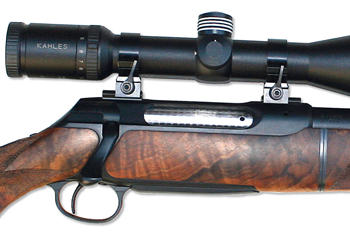Sauer 202 Take Down rifle review

Sauer 202 Take Down rifle review
Manufacturer: Sauer
Sauer 202 Take Down rifle.
Sauer continues to set a standard by which other high-end stalking rifles are compared and its product range continues to grow.
Having catered for both stalkers, fox and vermin shooters? needs and target shooters with its match rifle, Sauer has now developed a Take Down version of its ever-popular flagship 202 full-bore rifle.
The rifle can be disassembled with the fore-end and barrel removed and ready for transportation within 10 seconds.
This allows for a swift barrel change and means that those wishing to take the rifle overseas can pack a set of two or more barrels for any game species into a small travelling case.

The test rifle came in two calibres suitable for deer or big game shooting, with two bolt mounts and a handy carry case.
ACTION, TRIGGER AND SAFETY
With the Sauer rifle, the action is the unit to which all the other items are attached. The bolt locks into the back end of the barrel via three large forward-locking lugs and three smaller ones behind them.
On the right side of the bolt face is a single claw extractor for positive case extraction while ejection occurs via a conventional sprung plunger.
The bolt lift or elevation is small because of the locking lug arrangement, which helps in making the Sauer?s bolt fast to operate.
It also avoids fouling a low-mounted scope and makes it smooth to use.
There are separate scope mounts which have small threads ? you must take care not to strip them and ensure they do not foul the barrel union below by over-screwing.
The single-set trigger mechanism is common on European rifles and is there if you want it.

It significantly lightens the trigger pull, which is initiated by pushing the blade forward 0.5in. I found it a fraction too light for frosty weather.
The safety catch is unusual, being situated at the rear of the action within a recess. Its plunger, when depressed, makes the rifle safe.
It is completely silent, which is handy on a sporting arm.
As it is depressed, a button positioned inside the trigger-guard protrudes downward in front of the trigger-blade.
You then push this back in to remove the Sauer from ?safe? to ?fire?.
The magazine is a detachable box with a capacity of three rounds in .27 calibre.
You can get four in the .375 Holland & Holland extended magazine with a single-column feed box.
STOCK
The stock is attractive in grained walnut and the fore-end is slender with a solid grip provided by neatly chequered panels on each side.
The butt section is in the Monte Carlo style, with a well-defined comb and comfortable cheekpiece.
The pistol grip is slender at the action end, but soon fills the hand as the grip?s rake and form provides a nice palm swell.
There is a good solid black recoil pad and a recessed quick detachable sling-swivel stud.
Again, nicely chequered for looks and grip, the Sauer?s stock gives it an air of opulence.
The union between the fore-end and the action section makes this stock a three-piece unit, rather than the normal two-piece configuration and it allows the two sections of the fore-end to fit together perfectly.
Their faces are steel-clad and blued, allowing the fore-end stud clamp to fix itself securely, negating any lateral movement.
ACCURACY AND TARGETS
I had the choice of a .27 calibre barrel for plains game or deer in the UK and .375 H&H cartridge for big game or boar.

I fitted each barrel in turn to the rifle and checked accuracy and velocity and more importantly, the first round zero and overall group zero.
With the .27 barrel fitted and using the 140-grain Accubond load, the first shot went 1.5in to 2in high and 1in to the right, the second shot dropped into zero as did the third and fourth producing a group of 1.5in.
Similarly, the .375 H&H barrel did the same with the first shot ? at least 2in high and to the right of the zero.
Overall accuracy was excellent, however, with the reload using the Sierra 300-grain bullet at 2,433fps producing sub-1in groups at 100 yards.
As the first shot is fired, the action and barrel tighten beyond what hand pressure can muster.
To resolve the wide first shot, I slid the barrel in as normal and, resting the muzzle carefully on a pencil eraser to protect the crown, pushed down on the butt, getting a much tighter barrel-to-action union and a far better first shot.
BARREL
The beauty of Sauer rifles is that the barrels are easily exchanged for a wide variety of calibres, lengths or profiles to adapt to any of your sporting needs.

The 202 Take Down has a differing arrangement, as the fore-end is quickly detachable by pressing the sling fitment stud.
This releases a circular locking stud arrangement that locks the fore-end to the action.
There are no retaining screws on the barrel, only a friction fit and locating lug.
But you cannot pull the barrel out by hand, you have to support the rifle on the butt and then hold the barrel with the other hand.
Then, open and slam back the bolt as though you are loading a round. This fast reciprocating action breaks the tension between the barrel and action and the barrel slides out.
As long as the head diameter of the cartridge matches the bolt-face diameter you can mix and match cartridges.
For the test rifle, I used .27 and .375 Holland & Holland so it came with two differing bolts all housed in a purpose-built and well-appointed velvet-lined travelling case.
The .27 barrel was a standard Sporter profile, while the .375 had a medium and heavier profile that is beneficial in reducing some of the huge recoil this cartridge produces.
 CONCLUSION
CONCLUSION
Sauer makes solid, elegant sporting rifles with a plethora of optional stocks, barrels and sighting arrangements.
The 202 Take Down will appeal to the shooter who travels a lot and encounters many different species necessitating the use of various calibers.
Sauer 202 Take Down rifle
£4595
Tel: Garlands on 01827 383300








